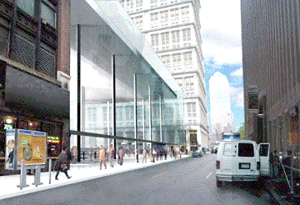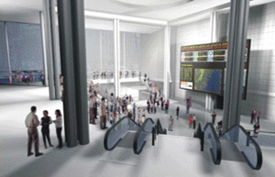|
A conceptual view of how the MTA is planning for the new Fulton Street Transit Center at the corner of Broadway to look |
Rush hour in New York, 2015: At the World Trade Center Transportation Hub, a commuter gets off the PATH train from Jersey City and walks two blocks to his office in the 1776-foot-tall tower on Fulton Street. At the nearby Fulton Street Transit Center -- airy, brightly lit, and easy to navigate -- a downtown resident takes the #2 subway train uptown to her job in Times Square. At the same time, a family from Japan gets off their flight at John F. Kennedy Airport and boards a train that goes directly to the 9/11 memorial on the former site of the old World Trade Center. And a Wall Street executive from Greenwich arrives on time to work via the Second Avenue subway, using an easy connection at Grand Central Terminal.
Those who currently live and work in lower Manhattan could easily see this scenario as science fiction.
Today, downtown subway stations are archaic and uninviting. The streets seem to be a perpetual construction zone. Added security and barriers, such as at the New York Stock Exchange on Broad Street, create a war zone atmosphere. West Street remains a barrier to the World Financial Center and Battery Park City. Connections among subway lines are confusing or non-existent.
The tragedy in lower Manhattan highlighted the inherent weaknesses in the transportation system serving it, particularly in contrast to Midtown. With no direct commuter rail access from New Jersey, Long Island or Westchester (Midtown has direct access from all three), lower Manhattan has been at a competitive disadvantage to attract businesses for several decades.
Rebuilding lower Manhattan after September 11 has meant not only restoring the transportation that was damaged during the attacks, but improving many parts of the transportation system downtown.
In October 2002, Governor George Pataki submitted a request for funding for lower Manhattan transportation projects to the Federal Emergency Management Agency and the Federal Transit Administration. Early this year, they agreed to together provide $4.55 billion. The approved projects include a transit hub at the World Trade Center site, with underground connections to a new subway complex called the Fulton Street Transit Center. Pataki’s list also includes the rebuilding of the dysfunctional South Ferry 1/9 subway station and improvements to lower Manhattan streets and public places. In addition, the governor has called for tunneling part of West Street and a further study of how best to connect lower Manhattan to the airports.
World Trade Center Transportation Hub
The World Trade Center Transportation Hub involves the construction of a temporary and then a permanent PATH station, with pedestrian connections to the E train station, the existing N/R station, and entirely reconstructed 1/9 station. An underground walkway under Dey Street will link the hub to the Fulton Transit Center, which will incorporate four subway stations and nine subway lines. It will have another walkway under West Street that connects to Battery Park City. The cost of the project is estimated at between $1.7 and $2 billion, and it will be completed in phases by early 2009.
One controversial element about the hub, which has still not been resolved, is how much retail space will be built underground in the hub’s passageways. While retail developers are anxious to build as many stores underground as possible to attract business from commuters walking through the station each day, building too many stores underground would create a mall that could sap the life from the surrounding streets. To build a vibrant neighborhood in lower Manhattan, as much retail space as possible should be built at street level.
Another issue is the possibility of including a terminal under the World Trade Center site to house tourist buses. The city and local residents say the bus terminal would keep foul-smelling buses from lining up on crowded local streets, but many family members of those lost on 9/11 are offended by the thought of buses stored where their loved ones died. While some bus parking, especially for school buses, may be necessary, it can be kept to a minimum by encouraging tourists who visit the 9/11 memorial to use ferries and subways.
Fulton Street Transit Center
|
The MTA's design concept for the John Street and Broadway entrance to the Fulton Street Transit Center. |
The Fulton Street Transit Center to the east is being planned by the Metropolitan Transportation Authority. The station complex, which includes four stations and nine subway lines, the 2, 3, 4, 5, A, C, J, M, and Z, is a maze that challenges the savviest New Yorker. The MTA plans to open up the Lexington Avenue station entrance by razing some or possibly all of the properties on the east side of Broadway from Fulton to John Streets. The authority also plans to simplify the pathways and make it easier for people to see where to go when transferring from one line to the other. See the MTA website for more details. Many preservationists are very worried that historic buildings, most notably the Corbin Building on John Street, will be torn down or damaged to make way for the new station. This 1889 building, with its terra cotta façade, is one of the area’s first skyscrapers. The MTA should preserve the façade of the building and incorporate it into the design of the new station. The cost for the transit center is $750 million, and it is scheduled to be completed by 2007.
New South Ferry Subway Station
The new South Ferry subway station will overcome the many deficiencies of the existing station, such as platforms the length of just half a subway train, delays caused by slow trains forced to negotiate an almost impossibly tight curve, and a single overcrowded exit. The station, which serves as a gateway for tourists destined for Liberty and Ellis islands, is an embarrassment as it is now.
The original design for the replacement would have torn up part of Battery Park, cutting down dozens of trees on the east side of the park. After the Battery Conservancy and other groups complained, the MTA decided to rethink the design. A new plan has been devised by the MTA, and it is a big improvement. The station would now be located mostly outside and east of the park. Building it will do little damage to the park, and the new plan brings the station closer to others in lower Manhattan to make transferring easier. It will also be closer to the Staten Island ferry terminal than the first plan. The earlier design was to cost $400 million and be completed by 2007, but costs and timing of the new design are not yet available.
West Street
West Street presents a barrier for pedestrians who want to go to and from the World Financial Center and parts of Battery Park City. Prior to 9/11, two pedestrian overpasses helped walkers cross the 200-foot-plus-wide highway. The more heavily used overpass, which went directly into the Winter Garden, was destroyed and will likely be replaced.
Initially, there was much interest in burying West Street in a tunnel from the World Trade Center site all the way to the Battery, but cost estimates were so high that the New York State Department of Transportation is investigating less ambitious plans – either a short tunnel from Vesey to Liberty Streets, which the governor has recently called for, or a deck over West Street into the World Financial Center across the way. This deck or platform would bridge over the existing highway. Depressing the highway in a tunnel would almost certainly be more expensive, but it would improve access to the World Financial Center and the ferry services beyond on the Hudson River and would better protect the memorial site from the noise of traffic. Some downtown residents have opposed a tunnel, saying it isn’t necessary and will require a disruptive construction zone. The New York State Department of Transportation is currently making presentations about the tunneling and decking options, after which the public will be in a better position to judge which plan will work best. Costs have not been determined for either project.
Airport Connections
In the governor’s letter to the federal government, he indicated that local agencies would be working to provide direct access from lower Manhattan to Newark and Kennedy airports. Much of the PATH line to Newark is already in place, and the project’s viability will depend on its cost and whether it can operate without affecting existing PATH services. The Port Authority is examining this.
For Kennedy airport, the options are more varied. New subway connections with Brooklyn could bring trains into lower Manhattan from Jamaica to serve Long Island commuters and also provide for an easy transfer to the Kennedy Airport Airtrain, to open next year. But many worry that the new trains would interfere with existing subway service and do little to cut the travel time for Long Islanders going directly to lower Manhattan. Mayor Michael Bloomberg has proposed creating a new tunnel under the East River, which would provide a one-seat ride to Kennedy Airport and could also provide a connection to the Long Island Rail Road.
The Regional Plan Association, where I am a senior fellow for transportation, strongly supports a new East River tunnel. However, the association’s plan is for the airport connection to be linked to the planned Second Avenue subway, which is designed to allow an extension into Brooklyn. Governor Pataki has asked the Lower Manhattan Development Corporation, along with the MTA and the Port Authority, to sort through the alternatives and make a recommendation by next spring. Where the funding for any airport project will come from is not yet clear.
Second Avenue Subway
Incredibly, overlooked in all of the discussions about lower Manhattan transportation is the project that the MTA has already committed to, the Second Avenue subway. It would add two new subway services to lower Manhattan and unclog a third, the notorious Lexington Avenue express. The MTA supports placing the new subway line in lower Manhattan underneath Water Street on the east side. If this line is extended, it could connect with Brooklyn and the Long Island Rail Road as described above. (The portion of the line in Manhattan is the subject of MTA hearings scheduled for May 12 and 13.)
Fixing Downtown Streets
Lower Manhattan’s streets are barricaded for security reasons and overcrowded with pedestrians competing for limited space with many types of vehicles, all with a claim to the same space. Security needs to be provided without creating an “armed camp” atmosphere. A solution for overcrowding should allocate space according to the need to move people and goods, and recognize the important role of streets and sidewalks as part of the public realm. This can be done by creating a plan for lower Manhattan’s “public realm,” including closing some streets to traffic, and building park-like boulevards and small parks. The governor’s recent allocation of funds for streets and parks is a step in the right direction.
The transportation system must be made whole again. Otherwise, the willingness of commuters and others traveling to lower Manhattan on business or to shop, will slowly, but assuredly erode. So will the resolve of the area’s residents. People will be unwilling to stand the inconvenience and lost time, when other options, whether in Midtown, the rest of New York City and suburbs or worse, other areas outside the region, are available. To overcome this potentially mortal blow to the financial district, the transportation system must entice back those who have left, overcoming the system’s weaknesses that existed before 9-11.
Jeffrey M. Zupan is senior fellow for transportation at Regional Plan Association, the not-for-profit research, planning and advocacy organization in the tri-state region.






